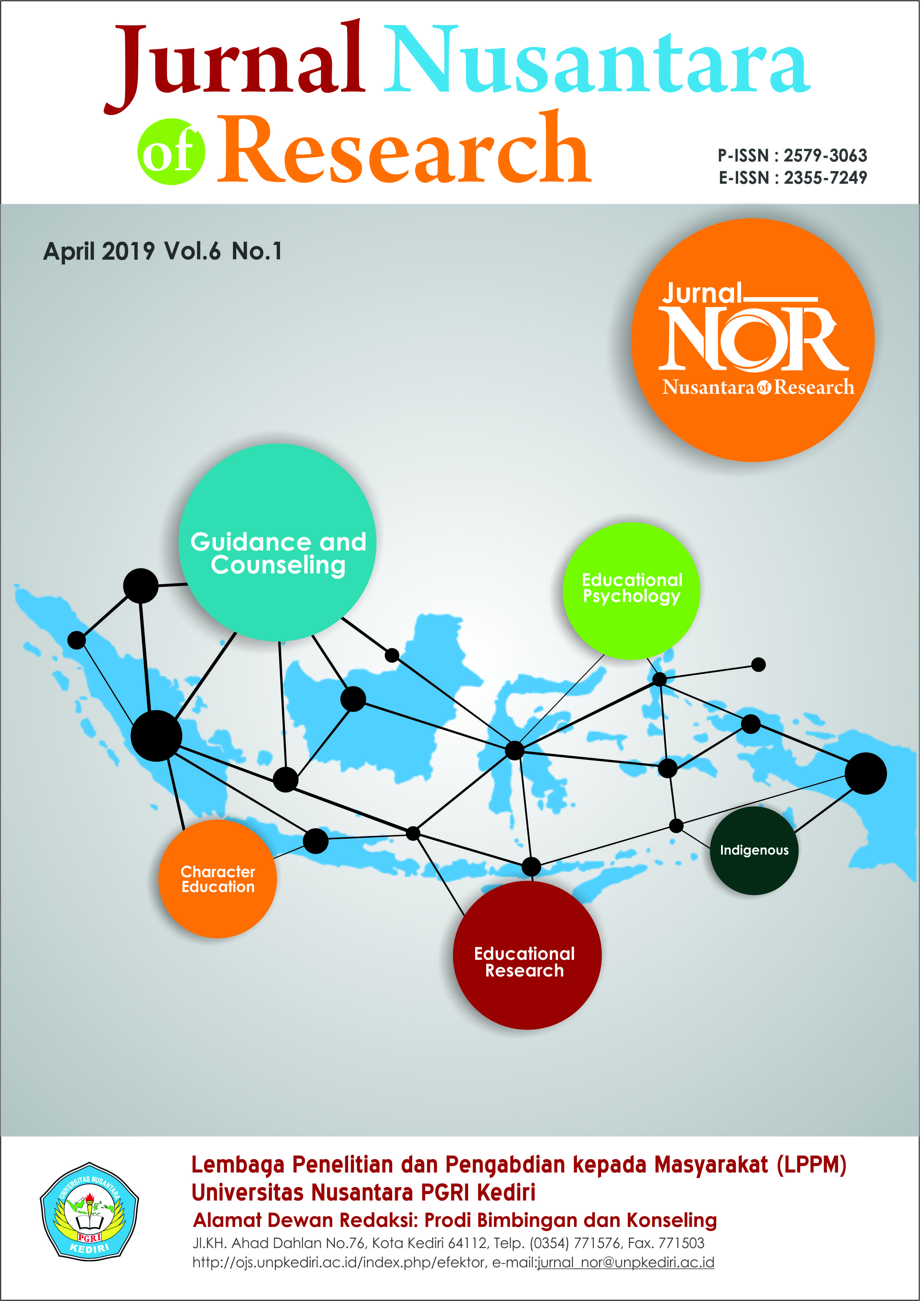Keefektifan Teknik Modeling Berbasis Sinema Edukasi untuk Meningkatkan Efikasi Diri Akademik Siswa SMP
Main Article Content
Abstract
Phenomenon Students with low academic self-efficacy tend to avoid difficult tasks, because the task is considered a threat to him. Students have low aspirations and commitment in achieving the learning goals they set. When faced with difficult tasks, student is busy thinking about the deficiencies that exist in him, the disturbances he faces, and all the results that can be detrimental. When faced with difficult tasks, students with low self-efficacy will reduce their efforts and tend to give up quickly and slow to fix or regain their self-efficacy when experiencing failure. So we need a technique to reduce these rights, one of which is the application of modeling techniques based on cinema of educational. This study aims to determine the effectiveness modeling techniques based on cinema of educational to improve students' academic self-efficacy. This research method uses an experimental research approach with the type of one group pretest-posttest design. The conclusion of the study showed that the Paired Samples Test score was 0.026 <0.05. These results can be concluded that modeling techniques based on cinema of educational are effective for increasing the academic self-efficacy of junior high school students.
Downloads
Article Details
Issue
Section
Authors who publish with this journal agree to the following terms:
- Copyright on any article is retained by the author(s).
- The author grants the journal, the right of first publication with the work simultaneously licensed under a Creative Commons Attribution License that allows others to share the work with an acknowledgment of the work’s authorship and initial publication in this journal.
- Authors are able to enter into separate, additional contractual arrangements for the non-exclusive distribution of the journal’s published version of the work (e.g., post it to an institutional repository or publish it in a book), with an acknowledgment of its initial publication in this journal.
- Authors are permitted and encouraged to post their work online (e.g., in institutional repositories or on their website) prior to and during the submission process, as it can lead to productive exchanges, as well as earlier and greater citation of published work.
- The article and any associated published material is distributed under the Creative Commons Attribution-ShareAlike 4.0 International License
How to Cite
References
Bandura, A. 1977.Social Learning Theory. USA: Prentice-Hall
Bandura, A. (1986). Social Foundations of Thought and Action. Englewood Cliffs, NJ: Prentice Hall.
Bandura, A. 2009.Self Efficacy in Changing Societies. New York: Cambridge University Press.
Bell,1986. Learning and Instruction, Theory and Practice. New York : Macmillan Publishing Campany.
Benyamin, Courtney L., Puleo, Connor M., Settipani, Cara A., Brodman, Douglas M., Edmund, Juli M., Cummings,
Colleen M., Kendall, Philip M., (2011). History of Cognitive-Behavioral Therapy (CBT) in Youth. Journal List NIH Public Access. 20 (2): 179-189.
Bernstein, A. & Burn, A. 2019. Perspectives: A dialogue Upon The Question Of Value In Film Education. Film Education Journal. 2 (1): 71–8.
Chambers, J.2019. Exploring co-creation in practical film education from primary school to postgraduate study: Theoretical and auto-ethnographic perspectives upon teaching film practice. Film Education Journal. 2 (1): 27–47.
Cohen, L., Manion, L., & Morrison, K. 2007.Research Methods in Education (6thed.). London, New York: Routllege Falmer.
Cormier,W.H.and Cormier, L.S. (1985). Interviewing Strategies for Helpers: Fundamental Skill Cognitive Behavioral Interventions. Monterey, California: Brooks/Cole Publishing Company.
Creswell, J., W., 2012. Research design Pendekatan kualitatif, Kuantitatif dan Mixed; Cetakan ke-2.Yogyakarta: Pustaka Pelajar.
Elliott, Stephen N., Thomas R. Kratochwill, Joan Littlefield Cook, John F. Travers. 2000. Educational Psychology; Effective Teaching, Effective Learning. Third Edition. United States: The Mc Graw Hill Companies, Inc.
Ferla, J,. Valcke, M,. Cai, Y. 2009. Academic self-efficacy and academic self- concept: reconsidering structural relationships. Learning and Individual Differences. 19 (4) 499-505.
Gore, P.A. 2006. Academic self-efficacy as a predictor ofcollege outcomes: Two incremental validity studies. Journal of Career Assessment. 14 (1) 92-115.
Hen, M & M. Goroshit. 2012. Academic Procrastination, Emotional Intelligence, Academic Self-Efficacy, and GPA: A Comparison Between Students With and Without Learning Disabilities. Journal of Learning of Disabilities. XX (X) 1-9.
Kresse,W., & Watland, K.H. 2016. Thinking Outside the Box Office: Using Movies to Build Shared Experiences and Student Engagement in Online or Hybrid Learning. Journal of Learning in Higher Education. 12 (1).
Loucas T. L & Zacharias C. Z. 2012. Modeling-Based Learning In Science Education: Cognitive,Metacognitive, Social, Material And Epistemological Contributions. Educational Review. 64 (4) 471–492.
Njoku, N.C. 2016. Impact of Nigerian Home Video/Movie Industry on the Moral Behaviours of Secondary School Students in Ebony State of Nigeria. Journal of Education and Practice. 7 (26) 182-186.
Schunk, D. H., & Zimmerman, B. J. (2007). Influencing Children’s Self-Efficacy And Self-Regulation Of Reading And Writing Through Modeling. Reading and Writing Quarterly. 23 (1) 7-25.
Sugiyono. 2012. Metode Penelitian Kuantitatif Kualitatif dan R&D. Bandung: Alfabeta.
Yakar, H.G. 2018. Use of the Movies in the Turkish Language and Literature Education in Turkey. Journal of Education and Learning. 7 (3) 41-55.




